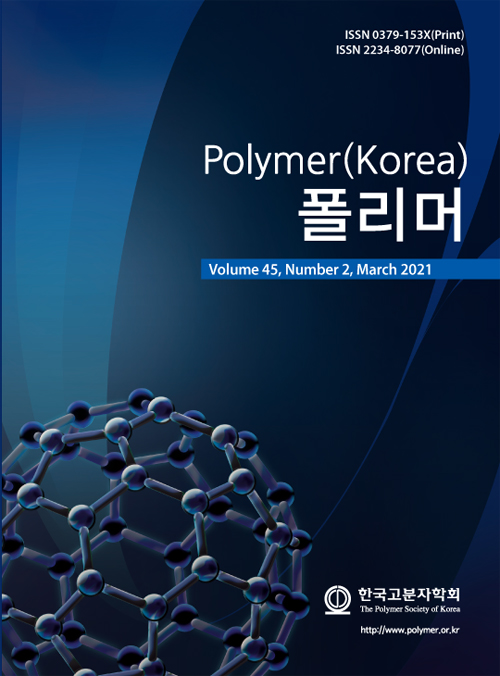- Carborane Reinforced PS-b-P2VP Block Copolymer Nanopatterns
Green and Sustainable Materials R&D Department, Korea Institute of Industrial Technology, Cheonan, Chungnam 31056, Korea
*Division of Advanced Materials Engineering, Kongju National University, Cheonan, Chungnam 31080, Korea- Carborane을 이용한 PS-b-P2VP 블록공중합체 나노패턴의 식각 저항성 향상
한국생산기술연구원 친환경융합소재부문, *공주대학교 신소재공학부
Reproduction, stored in a retrieval system, or transmitted in any form of any part of this publication is permitted only by written permission from the Polymer Society of Korea.
Block copolymers self-assembly has been intensively studied because they offer a simple and low-cost nanopatterning method which can be applicable in various fields. Polystyrene-b-poly(2-vinyl pyridine) (PS-b-P2VP) is one of most commonly used block copolymer due to its advantages such as easy control of pattern morphology, large-area orientation, and simple process for metal substitution. However, since it is composed of only organic polymers, it has insufficient etching selectivity between two blocks required for pattern transfer. In this study, we show that with a simple process, carborane compound can be selectively introduced into the P2VP domain of PS-b-P2VP which can significantly improve the etching resistance of the P2VP block. This result can provide important clue to solve the common problem of low etching selectivity in block copolymers composed of organic materials, and therefore it is expected that the usefulness of block copolymers as various nanolithographic templates could be further expanded
블록공중합체를 이용한 저비용, 고효율 나노패턴 제조 기술은 다양한 분야에 활용성을 가지고 활발히 연구되고 있다. Polystyrenre-b-poly(2-vinyl pyridine)(PS-b-P2VP) 블록공중합체는 패턴 정렬의 용이성, 대면적 배향 가능, 금속 치환 가능 등의 장점으로 범용적으로 사용되는 블록공중합체이지만 유기물로만 구성되어 있기에 패턴 전사에 필요한 식각 선택도(etching selectivity)가 부족한 한계를 가지고 있다. 본 연구에서는 간단한 공정으로 carborane 화합물을 PS-b-P2VP의 P2VP 블록에 선택적으로 도입시킬 수 있는 방법을 제시하여 P2VP 블록의 식각 저항성을 크게 향상시킬 수 있음을 보였다. 이 연구 결과는 유기물로만 이루어진 대부분의 블록공중합체의 낮은 식각 선택도 문제를 극복하는데 중요한 단서를 제공해 줄 수 있을 것이며 향후 블록공중합체의 다양한 나노 패턴 주형으로서의 활용성을 더욱 넓힐 수 있을 것으로 기대한다
Keywords: block copolymer, nanopattern, nanolithography, carborane, etching selectivity
- Polymer(Korea) 폴리머
- Frequency : Bimonthly(odd)
ISSN 0379-153X(Print)
ISSN 2234-8077(Online)
Abbr. Polym. Korea - 2023 Impact Factor : 0.4
- Indexed in SCIE
 This Article
This Article
-
2021; 45(2): 314-321
Published online Mar 25, 2021
- 10.7317/pk.2021.45.2.314
- Received on Jan 9, 2021
- Revised on Dec 28, 2020
- Accepted on Feb 1, 2021
 Correspondence to
Correspondence to
- Hong Kyoon Choi
-
Division of Advanced Materials Engineering, Kongju National University, Cheonan, Chungnam 31080, Korea
- E-mail: hkchoi@kongju.ac.kr









 Copyright(c) The Polymer Society of Korea. All right reserved.
Copyright(c) The Polymer Society of Korea. All right reserved.